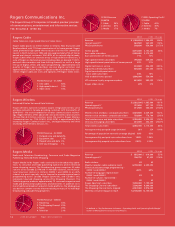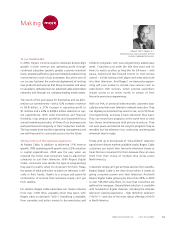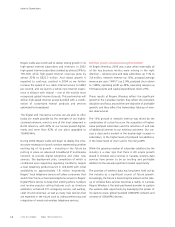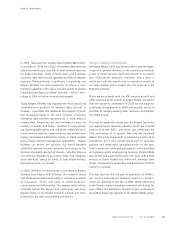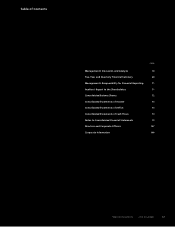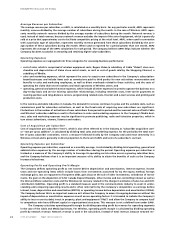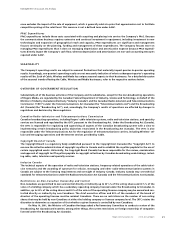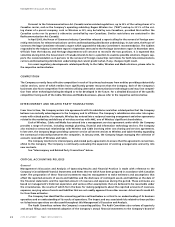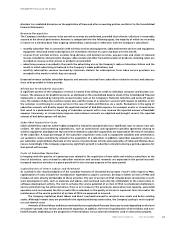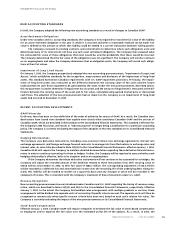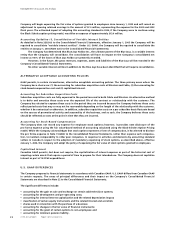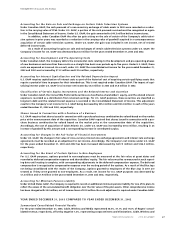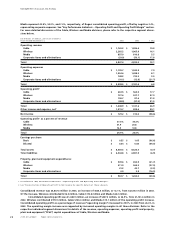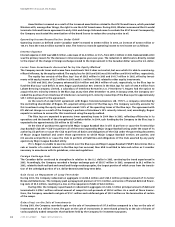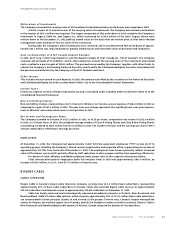Rogers 2003 Annual Report Download - page 23
Download and view the complete annual report
Please find page 23 of the 2003 Rogers annual report below. You can navigate through the pages in the report by either clicking on the pages listed below, or by using the keyword search tool below to find specific information within the annual report.
2003 Annual ReportRogers Communications Inc. 21
Management’s Discussion and Analysis
enue excludes the impact of the sale of equipment, which is generally sold at a price that approximates cost to facilitate
competitive pricing at the retail level. This measure is not a defined term under GAAP.
PP&E Expenditures
PP&E expenditures include those costs associated with acquiring and placing into service the Company’s PP&E. Because
the communications business requires extensive and continual investment in equipment, including investment in new
technologies and expansion of geographical reach and capacity, PP&E expenditures are significant and management
focuses continually on the planning, funding and management of these expenditures. The Company focuses more on
managing PP&E expenditures than it does on managing depreciation and amortization expense because PP&E expendi-
tures directly impact the Company’s cash flow, whereas depreciation and amortization are non-cash accounting measures
required under GAAP.
SEASONALITY
The Company’s operating results are subject to seasonal fluctuations that materially impact quarter-to-quarter operating
results. Accordingly, one quarter’s operating results are not necessarily indicative of what a subsequent quarter’s operating
results will be. Each of Cable, Wireless and Media has unique seasonal aspects to their businesses. For a detailed discussion
of the seasonal trends effecting the Cable, Wireless and Media businesses, refer to the respective sections below.
OVERVIEW OF GOVERNMENT REGULATION
Substantially all of the business activities of the Company and its subsidiaries, except for the non-broadcasting operations
of Rogers Media, are regulated by the Canadian Federal Department of Industry, Science and Technology, on behalf of the
Minister of Industry (Canada) (collectively “Industry Canada”) and the Canadian Radio-television and Telecommunications
Commission (“CRTC”) under the Telecommunications Act (Canada) (the “Telecommunications Act”) and the Broadcasting
Act (Canada) (the “Broadcasting Act”), and, accordingly, the Company’s results of operations are affected by changes in
regulations and decisions by these regulators.
Canadian Radio-television and Telecommunications Commission
Canadian broadcasting operations, including Rogers’ cable television systems, radio and television stations, and specialty
services are licenced and regulated by the CRTC pursuant to the Broadcasting Act. Under the Broadcasting Act (Canada),
the CRTC is responsible for regulating and supervising all aspects of the Canadian broadcasting system with a view to
implementing certain broadcasting policy objectives enunciated in the Broadcasting Act (Canada). The CRTC is also
responsible under the Telecommunications Act for the regulation of telecommunications carriers, including Wireless’ cel-
lular and messaging operations and the Internet services provided by Cable.
Copyright Board of Canada
The Copyright Board is a regulatory body established pursuant to the Copyright Act (Canada) (the “Copyright Act”) to
oversee the collective administration of copyright royalties in Canada and to establish the royalties payable for the use of
certain copyrighted works. Historically, the Copyright Board (Canada) has been responsible for the review, consideration
and approval of copyright tariff royalties payable to copyright collectives by Canadian broadcasting undertakings, includ-
ing cable, radio, television and specialty services.
Industry Canada
The technical aspects of the operation of radio and television stations, frequency-related operations of the cable televi-
sion networks and the awarding of spectrum for cellular, messaging and other radio-telecommunications systems in
Canada are subject to the licensing requirements and oversight of Industry Canada. Industry Canada may set technical
standards for telecommunications under the Radiocommunication Act (Canada) and the Telecommunications Act (Canada).
Restrictions on Non-Canadian Ownership and Control
Non-Canadians are permitted to own and control directly or indirectly up to 331/3% of the voting shares and 331/3% of the
votes of a holding company which has a subsidiary operating company licenced under the Broadcasting Act (Canada). In
addition, up to 20% of the voting shares and 20% of the votes of the operating licencee company may be owned and con-
trolled directly or indirectly by non-Canadians. The chief executive officer and 80% of the members of the board of
directors of the operating licencee must be resident Canadians. There are no restrictions on the number of non-voting
shares that may be held by non-Canadians at either the holding company or licencee company level. The CRTC retains the
discretion to determine as a question of fact whether a given licencee is controlled by non-Canadians.
On May 10, 2001, the Minister of Canadian Heritage asked a Parliamentary Committee to conduct a review of the
Broadcasting Act (Canada) and examine, among other things, the current restrictions on foreign ownership of companies
licenced under the Broadcasting Act (Canada).



